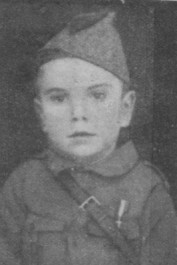
Edward Winter
Three photographs of Arturo Pomar Salamanca in our feature article Chess Prodigies:

Arturo Pomar, aged five
Source: opposite page 16 of La vida de
Arturito Pomar by J.M. Fuentes and J. Ganzo (Madrid, 1946)
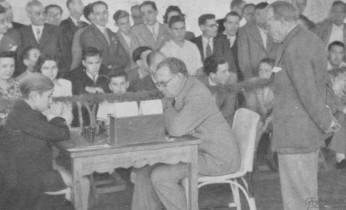
Arturo Pomar in play against
Alexander Alekhine, Gijón, July 1944
Source: see C.N. 5111 below.

Savielly Tartakower and Arturo
Pomar, London, 1946
Source: Chess Review, February 1946, page
9.
A number of C.N. items have shown Arturo Pomar’s games. See, for instance:
There follows a miscellany of other C.N. items about Pomar.
Compositions by notable players are always of interest. The following mate-in-three problems were composed by the Spanish prodigy Arturo Pomar (born 1931) when he was about ten years old, according to page 231 of La vida de Arturito Pomar by Juan M. Fuentes and Julio Ganzo (Madrid, 1946):
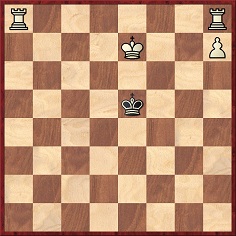
1 Ra4 Kf5 2 Rg8, or 1...Kd5 2 Rc8, etc.
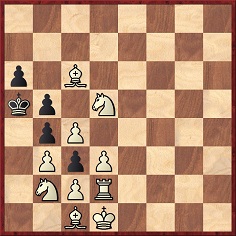
1 Na4 bxa4 2 Ba3, etc.
(1945)
This composition (White to draw) won second prize for A. Prokopchuk in a Ukrainian tourney in 1971 according to Study Database 2000:
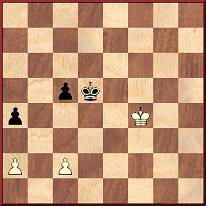
1 Ke3 Kc4 2 Kd2 Kb4 3 Kc1 Kc3 4 Kb1 Kd2

5 c4 Kc3 6 Kc1 Kxc4 7 Kc2 Kd4 8 Kd2 c4 9 Kc2 c3 10 Kd1 Kd5 (evidently a mistranscription of 10...Kd3) 11 Kc1 c2 12 a3 Drawn.
At move five White would seem to be in extremis, but the same drawing line had already occurred over the board, twice. The first such game we came across was between Beltrán and Pomar in the Spanish championship, Saragossa, October-November 1957, the ending of which was analysed on pages 103-104 of a little-known book by Arturo Pomar, Las pequeñas ventajas en el final (Madrid, 1958). We quote below his notes in full, and it will be seen that the play he recorded corresponds exactly to the above study. (The analysis in the book had three impossible moves or typos, and we have italicized them.)
‘As will be realized, Black should apparently win easily, by dint of having his king in a magnificent situation and well advanced pawns. However, after painstaking analysis White found the only precise move to draw, based on the plan of sacrificing a pawn to obtain the opposition.At the moment, Black is threatening to win with the following logical continuation: 1 Kg2 f4 2 Kg1 (if 2 Kh3 Kxf2 3 Kxh4 Kg2 4 Kg4 f3 5 h4 f2 6 h5 f1(Q), promoting the pawn with the advantage of several tempi) 2...f3 (or 2...h3 3 Kh1 Kf1 4 f3 Ke2 5 Kg1 Ke3 6 Kf1 Kxf3 7 Kg1 Ke2, winning) 3 h3 Ke1 4 Kh2 Kxf2, winning.
1 f4
With this move White ensures a draw.
1...Kf3
If 1...h3 2 Kh1 Kf3 3 Kg1 Kxf4 4 Kf2 Ke4 5 Ke2 (not 5 Kg3 Ke3 6 Kxh3 f4 7 Kg4 [7 Kg2 loses a tempo, owing to 7...Ke2] 7...f3, promoting the pawn several tempi ahead) 5...f4 6 Kf2 f3 7 Kf1 Ke3 8 Ke1 f2+ 9 Kf1 Kf3 stalemate.
2 Kf1 Kxf4
If 2...Kg4 3 Kg2 h3+ 4 Kf1 Kxf4 5 Kf2, transposing into the main line in the previous note.
3 Kf2 Ke4
If 3...h3 4 Ke2! Ke4 5 Kf2 f4 6 Ke2, etc.
4 Ke2 f4
If 4...h3 5 Kf2 Kd4 6 Kf3 Kd3 7 Kf2 (it is not possible to play 7 Kf4 Ke2 8 Kxf5 [if 8 Kg3 Ke3 9 Kxh3 f4, winning] 8...Kf3 9 Ke5 Kg2 10 Ke4 Kxh2 11 Kf3 Kg1, promoting) 7...Kd2 8 h3 Kd3 9 Kf1 Kd2 10 Kf2 and draws.
5 Kf2 f3 6 Ke1
6 Kf1? Ke3 7 Kf1 f2+ 8 Kf1 Kf3! 9 h3 Ke3 or Kg3, winning.
6...Ke3 7 Kf1
If 7 h3 Ke4! 8 Ke1 (if 8 Kf2 Kf4 9 Kf1 Kg3, winning) 8...Ke3 9 Kf1 f2 10 Kg2 Ke2, winning.
7...f2
If 7...Kf4 8 Kf2 Kg4 9 Kf1 Kh3 10 Kf2 Kxh2 11 Kxf3 h3 (if 11...Kg1 12 Kg4, winning the pawn) 12 Kf2 Kh113 Kf1, restricting the king to the h-file.
8 h3 Drawn.
The continuation would be 8...Ke4 9 Kxf2 Kf4 10 Kg2 Ke3 11 Kg1 Kf3 12 Kf1 Kg3 13 Kg1 Kxh3 14 Kh1 Kg3 15 Kg1 h3 16 Kh1, and drawn because it is a rook’s pawn.’
The comments in square brackets above are also by Pomar. He wrote that the pawn ending arose after ‘a very hard-fought game’, and we note that the score given in the Mega Database 2005 has a different conclusion: 1 d4 d5 2 Nf3 Nf6 3 c4 c6 4 Nc3 e6 5 e3 Nbd7 6 Bd3 dxc4 7 Bxc4 b5 8 Bd3 a6 9 e4 c5 10 e5 cxd4 11 Nxb5 axb5 12 exf6 Qb6 13 fxg7 Bxg7 14 Qe2 O-O 15 O-O Bb7 16 Re1 e5 17 Nh4 e4 18 Nf5 Nf6 19 Bxb5 Qc5 20 Nxg7 d3 21 Bxd3 exd3 22 Qxd3 Kxg7 23 Bf4 Rfe8 24 Qg3+ Kh8 25 Be5 Qb6 26 Qg5 Rxe5 27 Qxe5 Rg8 28 g3 Qc6 29 Re4 Re8 30 Qxf6+ Qxf6 31 Rxe8+ Kg7 32 Rb8 Qxb2 33 Rf1 Qb6 34 Rd1 h5 35 Rxb7 Qxb7 36 Rd4 Qb1+ 37 Kg2 Qxa2 38 Rf4 Kg6 39 Rh4 Kg5 40 Rf4 f5 41 Rh4 Qd2 42 Kg1 Kf6 43 Kg2 Qd5+ 44 Kg1 Ke5 45 Rf4 Qb7 46 Rh4 Qc6 47 Rf4 Qc1+ 48 Kg2 Qxf4 49 gxf4+ Kxf4 50 Kg1 Kf3 51 Kf1 h4 52 Kg1 Ke2 (Reaching the position in the diagram above.) 53 f4 Kf3 54 Kf1 Kxf4 55 Kf2 Ke4 56 Ke2 f4 57 Kf2 f3 58 Ke1 Kf4 59 Kf2 Ke4 Drawn.
The database has another game in which the same critical position arose: Berndt Söderborg (Sweden) v Dolfi Drimer (Romania) in the Fourth World Students’ Team Championship in Reykjavik, July 1957: 1 e4 c5 2 Nf3 d6 3 d4 cxd4 4 Nxd4 Nf6 5 Nc3 a6 6 Bg5 e6 7 f4 h6 8 Bh4 Qb6 9 Qd2 Qxb2 10 Rb1 Qa3 11 e5 dxe5 12 fxe5 Nfd7 13 Be2 Be7 14 Bxe7 Qxe7 15 Qf4 O-O 16 Ne4 Nc6 17 Nxc6 bxc6 18 O-O Rb8 19 Rxb8 Nxb8 20 Nf6+ Kh8 21 Bd3 Nd7 22 Kh1 Qc5 23 Nxd7 Bxd7 24 Qe4 g6 25 Qf4 Kg8 26 Rf3 a5 27 Qf6 Be8 28 h4 h5 29 Kh2 Qb4 30 Rg3 Qd2 31 Be4 a4 32 Qf3 c5 33 Qxh5 Qf4 34 Qg4 Qxe5 35 h5 f5 36 Qg5 Qxe4 37 hxg6 f4 38 Rg4 Bxg6 39 Qxg6+ Qxg6 40 Rxg6+ Kf7 41 Rg4 e5 42 g3 Rg8 43 Rxg8 Kxg8 44 gxf4 exf4 45 Kg2 Kf7 46 Kf3 Ke6 47 Ke4 f3 48 Kxf3 Kd5 49 Ke3 Kc4 50 Kd2 Kb4 51 Kc1 Kc3 52 Kb1 Kd2 (This position is identical to the one reached after move four in the Prokopchuk study.) 53 c4 Kc3 54 Kc1 Kxc4 55 Kc2 Kd4 56 Kd2 c4 57 Kc2 Kc5 58 Kc3 Kb5 59 Kc2 Kb4 60 Kb2 Kc5 61 Kc3 Kd5 62 Kc2 Kd6 63 Kc3 Kd5 64 Kc2 Kd4 65 Kd2 c3+ 66 Kc2 Kc4 67 Kd1 Kd5 68 Kc2 Kd4 69 Kd1 Kc5 70 Kc1 Kb4 71 Kc2 Kc4 72 Kd1 Kd3 73 Kc1 Ke4 74 Kc2 Kd4 75 Kd1 Kd3 76 Kc1 c2 77 a3 Kc3 Drawn.
When the conclusion of this game was given on page 140 of Pawn Endings by Y. Averbakh and I. Maizelis (Oxford, 1987) the colours were reversed (i.e. Drimer was given as White). Two coincidences in the games are striking: both were played in 1957 and both had the surprising advance of the bishop’s pawn at move 53.
The over-the-board intricacies of a simple-looking endgame are matched by the historical complications; in particular, what can be found out about Prokopchuk and his study and did Pomar’s book give an incorrect conclusion to his game?
(3611)
‘… Alekhine was receiving instruction preparatory to becoming a Catholic when he died suddenly at Estoril, states the Universe Lisbon correspondent.’
Source: CHESS, June 1946, page 198.
Writing in April 1946, Arturo Pomar, who was then aged 14, mused that he had perhaps helped the process, since Alekhine had even accompanied him to church. Here is the relevant passage from page 178 of Ajedrez español, June 1946:
‘Según noticias de la Prensa, el Dr Alekhine había tomado la determinación de convertirse al Catolicismo. Tal vez yo haya contribuido en algo a este deseo, pues algunos domingos, estando yo en su casa, tuvimos que separarnos por tener que ir yo a misa, y hasta una vez logramos, mi mamá y yo, que nos acompañase.’
The boy paid a warm tribute to Alekhine, describing him as a friend and adviser whose wise counsel he would never forget:
‘Para muchos, Alekhine no era más que el Campeón del mundo de este noble juego que es el ajedrez; para mí era algo más, muchísimo más, pues no tan sólo era el gran maestro el que se iba, sino el amigo, el consejero cuyos sabios consejos recordaré toda la vida y a los cuales debo gran parte de mis éxitos.’
(3116)
On the subject of the youngest-ever authors of chess books C.N. 543 (see page 108 of Chess Explorations) quoted a contribution from a US correspondent, John Rather, which included the following remark:
‘Pomar’s Mis Cincuenta Partidas con Maestros (1945) and Bobby Fischer’s Games of Chess (1959) were published when their nominal authors were 14 and 15 respectively, but the extent of their involvement in preparing the books is in doubt.’
Now Josep Alió (Tarragona, Spain) writes that Arturo Pomar cannot be regarded as the author of the 1945 book, and he therefore also takes issue with two references written by us in A Chess Omnibus:
Page 114: ‘Source: Mis Cincuenta Partidas con Maestros by A. Pomar (Madrid, 1945), pages 67-71.’
Page 325: ‘There cannot be many autobiographical works in which the birth-date of the subject is not only wrong but also, so to speak, inconceivable. Page 11 of Mis Cincuenta Partidas con Maestros by Arturo Pomar (Madrid, 1945) announced that he was born on 31 September 1931.’
Mr Alió comments:
‘The title-page is rather deceptive, but in reality the book’s author is the well-known Spanish chess writer of the 1940s, Manuel de Agustín, with Pomar referred to in the third person in the text. The correct title is Pomar. Mis cincuenta partidas con maestros.’
Below we reproduce the title page:
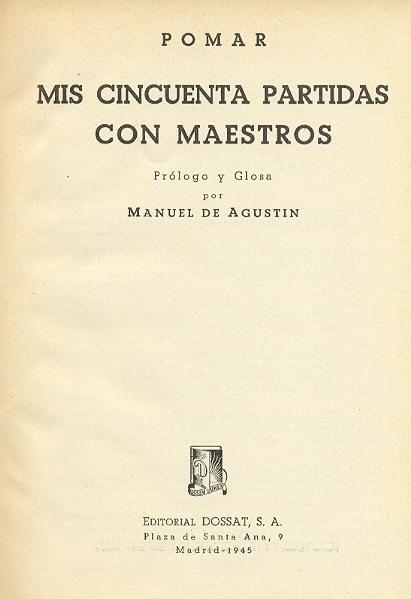
De Agustín was attributed responsibility for the introductory material and the notes. The title means ‘My 50 games with masters’, and authorship was ascribed to Pomar at the time (e.g. in a book list from the publisher on the inside front cover of Ajedrez Español, April 1946). Nonetheless, on the basis of the contents of the book we agree with Mr Alió’s strictures and shall no longer describe it as ‘autobiographical’.
(3988)
Miquel Artigas (Sabadell, Spain) informs us that he has acquired a copy of the book which de Agustín inscribed, referring to himself as ‘el autor’:
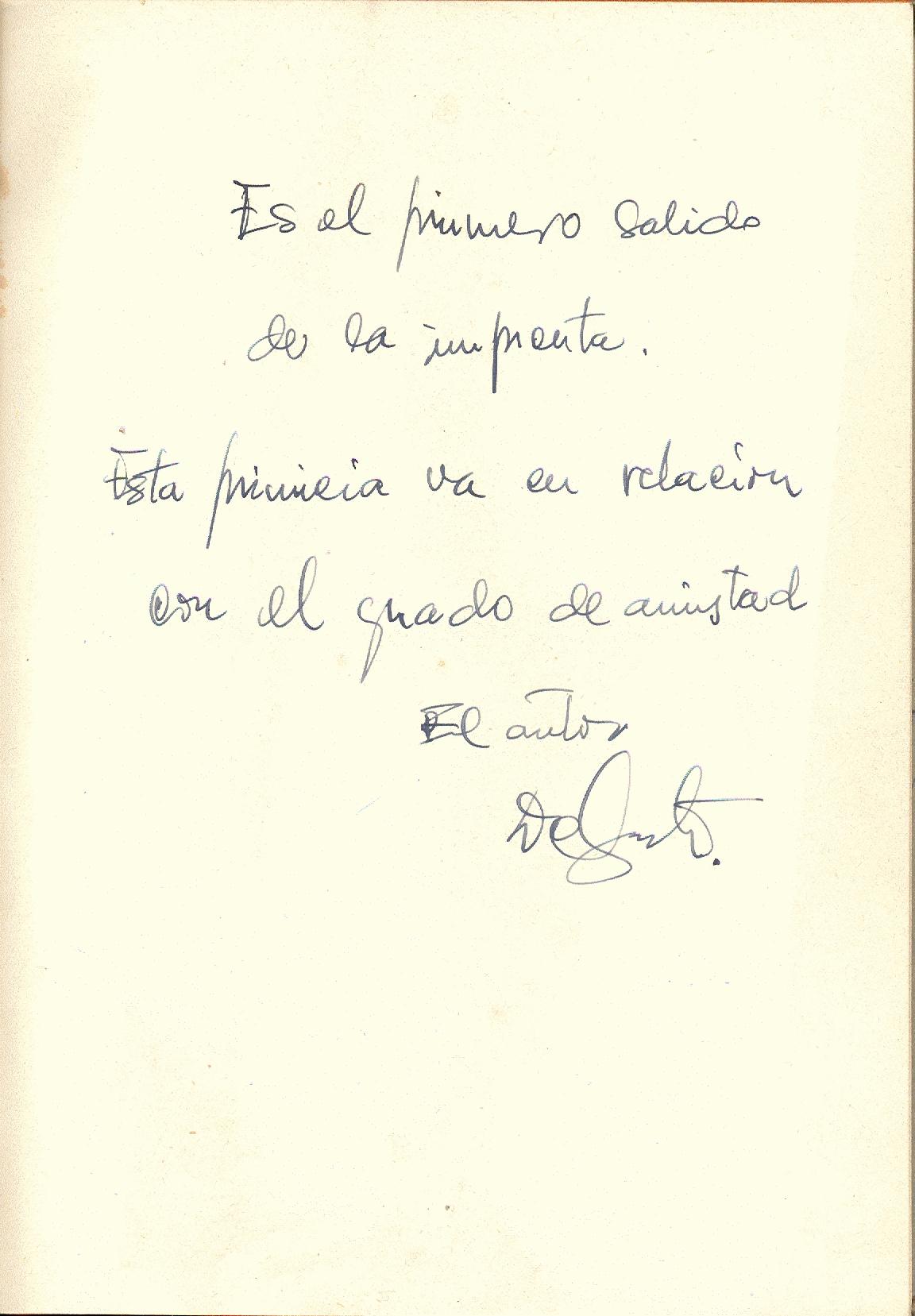
‘Es el primero salido de la imprenta. Esta primicia va en relación con el grado de amistad. El autor, De Agustín.’
(4086)
The photographs below come from the Gijón, 1944 tournament book, Torneo internacional de ajedrez by Juan Fernández R. Rúa (Madrid, 1945):
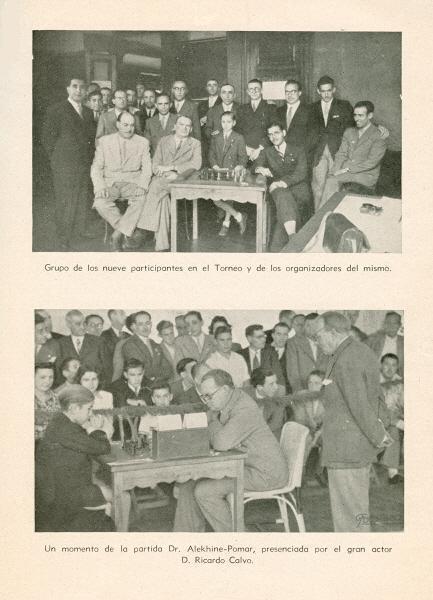
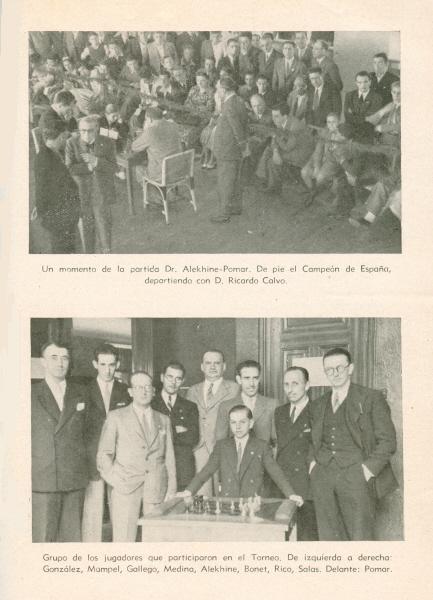
(5110)
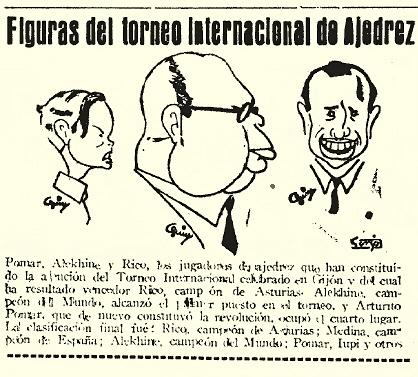
Christian Sánchez (Rosario, Argentina) sends the above cutting with caricatures of Arturo Pomar, Alexander Alekhine and Antonio Rico at Gijón, 1945, from page 6 of the Spanish (Cuenca) newspaper Ofensiva of 2 August 1945.
The caricature of Alekhine must be one of the last published during his lifetime.
(5307)
To the small number of photographs of Francisco Lupi which are available, we add one from opposite page 145 of La vida de Arturito Pomar by Juan M. Fuentes and Julio Ganzo (Madrid, 1946):
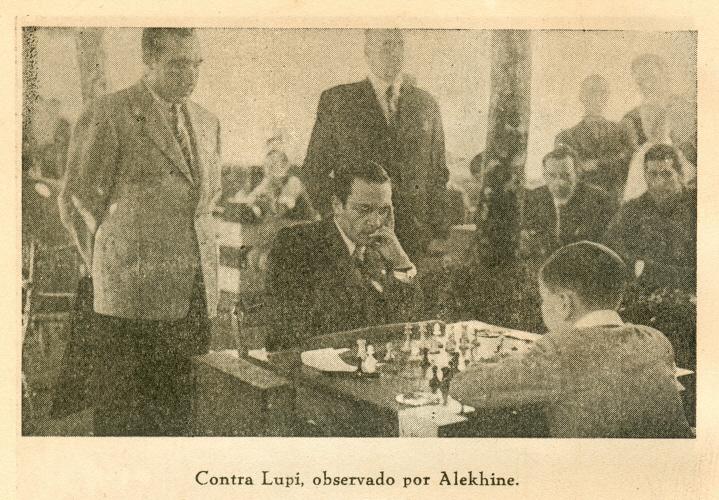
(5551)
Andrés Vicente Sanz (Valencia, Spain) submits this photograph of Arturo Pomar taken at the Sociedad Musical de Alboraya in the late 1950s or early 1960s:
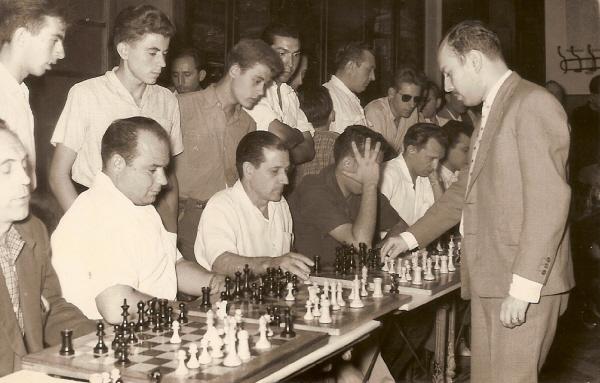
(5625)
Tim Jake Gluckman (Cologne, Germany) asks whether information is available on any contact between Francisco Franco and Arturo Pomar.
At present we can think of nothing apart from a photograph of them standing together, which was published, in small format, on the front cover of the 1 January 1997 issue of Jaque:
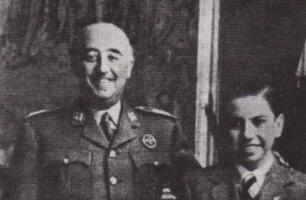
(5736)
After Javier Asturiano Molina (Murcia, Spain) informed us that a full-length picture of Francisco Franco and Arturo Pomar was published on page 50 of the 6/2002 issue of Peón de Rey, we contacted the magazine’s director, Amador Rodríguez, and he has sent us a copy for presentation here:

Mr Rodríguez comments:
‘We know for sure that Franco officially met Pomar twice, in 1944 and in 1946. From the picture, we estimate that it was most likely taken in 1946, when Pomar was 15 years old.’
(5801)
Concerning meetings between Arturo Pomar and General Franco, Javier Asturiano Molina draws attention to a photograph of another encounter (Madrid, 15 July 1959) in the archives of ABC.
(11865)
We recall three photographs of Arturo Pomar in play against Ossip Bernstein at London, 1946:
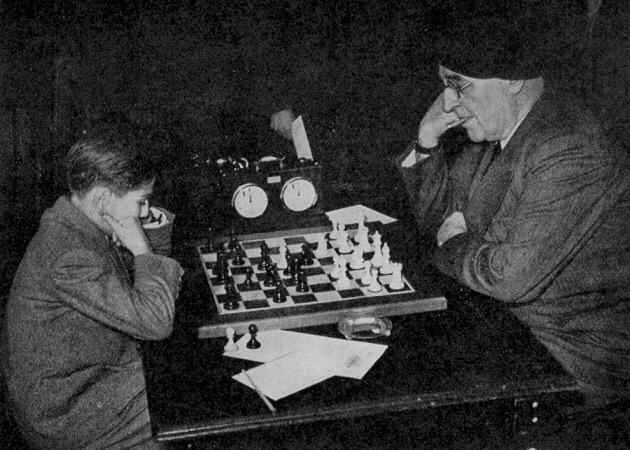
Sources: CHESS, February 1946, page 96; London, 1946 (Sutton Coldfield, 1946), page 10
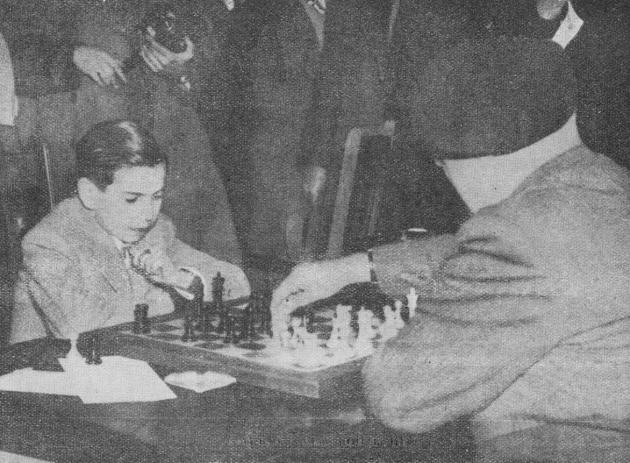
Source: La vida de Arturito Pomar by J.M. Fuentes and J. Ganzo (Madrid, 1946), opposite page 224
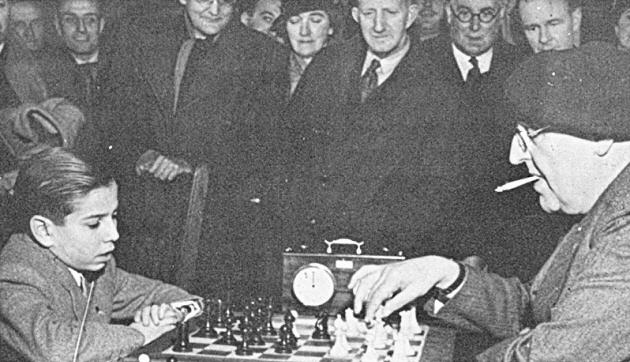
Source: The Encyclopedia of Chess by H. Golombek (London, 1977), page 28
However, in every source (including the above-mentioned tournament book and the volume on the event edited by E.G.R. Cordingley, as well as the The Times, the BCM and CHESS) where round-by-round reports and/or the game-score have been found it is stated that Pomar had the white pieces against Bernstein (the moves being 1 d4 d5 2 c4 e6 3 Nc3 Nf6 4 Bg5 Be7 5 e3 h6 6 Bh4 Ne4 7 Bxe7 Qxe7 8 cxd5 Nxc3 9 bxc3 exd5 10 Qb3 Qd6 11 Nf3 O-O 12 c4 dxc4 13 Bxc4 Nc6 14 O-O Na5 15 Qc3 Nxc4 16 Qxc4 Be6 17 Qb5 Bd5 18 Ne5 b6 19 Rfc1 c5 20 f4 cxd4 21 Rd1 Rfc8 22 Rxd4 Rc5 23 Qd3 Qe6 24 Rd1 Bxa2 25 Rd8+ Rxd8 26 Qxd8+ Kh7 27 Nd7 Qxe3+ 28 Kh1 Drawn).
When was the photographed game played?
(6573)
Leonard Barden (London) wonders whether the three Pomar v Bernstein photographs in C.N. 6573 were taken shortly before the London, 1946 tournament, to promote media interest:
‘In the third photograph the spectator standing one from the right is G.H. White, the leader of the consortium including G. Wood and B.H. Wood which bought out Edith Price from the Gambit Chess Rooms. The man clutching the chair with only the lower half of his face visible looks like Walter Veitch, who was a regular player at the Gambit.’
For purposes of comparison, below is a photograph of the first day’s play in the London tournament, published on page 6 of The Times, 15 January 1946:
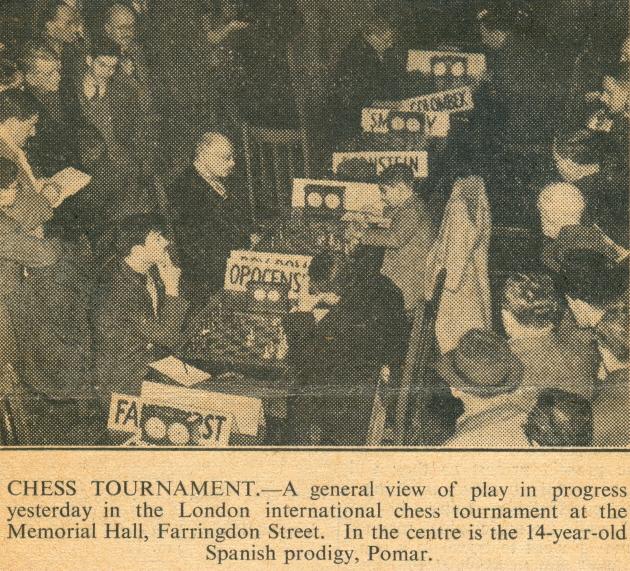
The newspaper’s report began:
‘An unfortunate hitch has occurred in the London chess tournament. The long expected Russian players have failed to turn up, and the players against whom they were paired awaited them in vain.’
The name-cards show that Smyslov was one of those expected and that he was scheduled to play Bernstein.
(6584)
From page 14 of London 1946, published by CHESS (Sutton Coldfield, 1946):
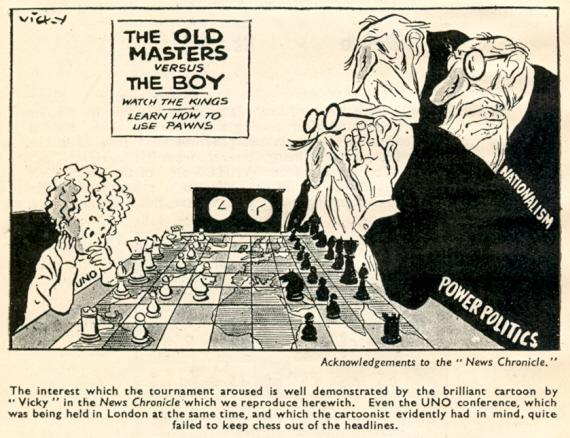
(6589)
Christian Sánchez reports that the third Pomar v Bernstein photograph in C.N. 6573 was published on page 42 of ABC, 20 January 1946. There was a picture credit to ‘Ortiz’.
He also draws attention to page 2 of El Mundo Deportivo, 24 January 1946, which mentioned that a photograph of Pomar in play against Bernstein had been published in the New York Times.
We have found that picture (the second one in C.N. 6573) on page 35 of the sports section of the New York Times, 22 January 1946. The (faulty) caption was: ‘Arturito Pomar of Madrid during his match with Dr O.S. Bernstein of Paris at international event in London. The young Spaniard and his opponent played to a draw.’
(6609)

Olimpiu G. Urcan (Singapore) notes a Pathé news item on the London, 1946 tournament, featuring Arturo Pomar in play (with the black pieces, as in the photograph above) against Ossip Bernstein, as well as footage of some other players, including Savielly Tartakower (briefly) and William Winter. The technical quality is good, with a commentary which is quintessentially English.
(6978)
A case of misidentification concerning the Pomar v Bernstein photograph given in C.N. 6573 occurs on page 68 of Arturo Pomar. Una vida dedicada al ajedrez by Antonio López Manzano and Joan Segura Vila (Badalona, 2009):
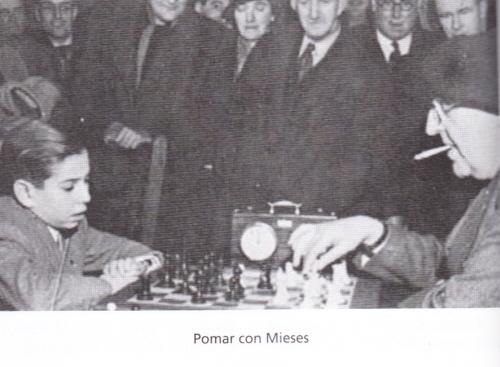
(7792)
The photograph below has been provided by Olimpiu G. Urcan from the Illustrated London News, 26 January 1946, page 102:
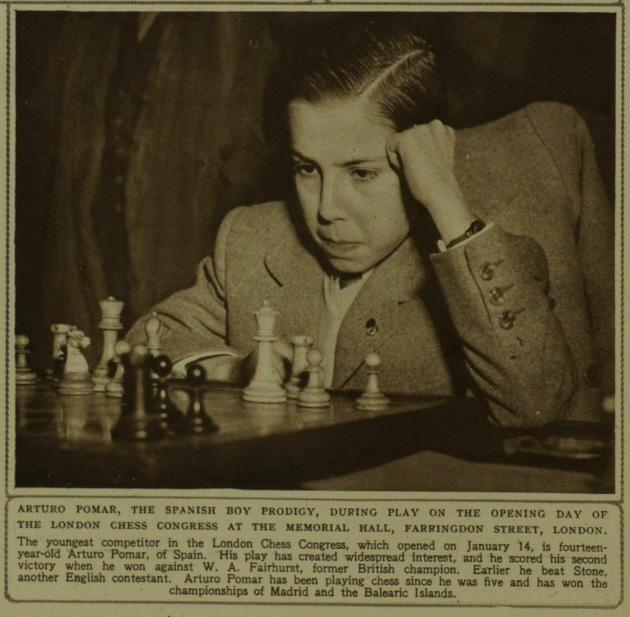
(7490)
Eduardo Bauzá Mercére (New York, NY, USA) offers a game from the 1958 Spanish championship which has the seesaw manoeuvre:
Arturo Pomar Salamanca – Eduardo Pérez Gonsalves
Valencia, 28 June 1958
Sicilian Defence
1 e4 c5 2 Nf3 e6 3 d4 cxd4 4 Nxd4 a6 5 Nc3 Bb4 6 Qg4 Nf6 7 Qxg7 Rg8 8 Qh6 Rg6 9 Qe3 Ng4 10 Qd3 d5 11 exd5 Qxd5 12 Bd2 Qe5+ 13 Be2 Bc5 14 Be3 Nxe3 15 fxe3 Bd7 16 O-O-O Nc6 17 Bf3 O-O-O 18 Ne4 Be7 19 Qc3 Bf8 20 Rd3 f5 21 Nxc6 Qxc3 22 Na7+ Kb8 23 Nxc3 Kxa7 24 Rhd1 Rg7 25 e4 Kb8 26 exf5 exf5 27 Ne2 Be7 28 Nd4 Rc8 29 Kb1 Bf6 30 Nb3 Bb5 31 Rd5 f4 32 Rf5 Bg5 33 Nc5 Bd8 34 Ne6 Rd7 35 Rxd7 Bxd7

36 Rf7 Bxe6 37 Rxb7+ Ka8 38 Rxh7+ Kb8 39 Rb7+ Ka8 40 Re7+ Kb8 41 Rxe6 a5 42 Rc6 Rxc6 43 Bxc6 Kc7 44 Bf3 Kd6 45 c3 Kc5 46 Kc2 Bf6 47 Kd3 a4 48 Bd1 Kb5 49 Ke4 a3 50 bxa3 Bxc3 51 Kxf4 Kc6 52 h4 Kd6 53 Bb3 Resigns.
Source: El Ajedrez Español, 1958, page 248.
(7881)
Thomas Höpfli (Schkopau, Germany) sends a link to a video report on Arturo Pomar which includes Fischer speaking a few words of Spanish.
(8201)
Shortly after Alekhine’s death, Arturo Pomar published a tribute which included some comments on his personal contact with the late world champion:
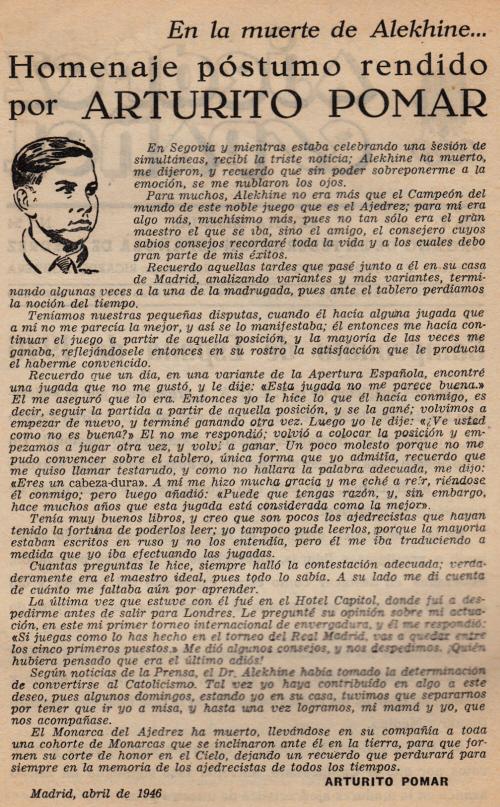
Source: Ajedrez Español, June 1946, page 178.
(8750)
Olimpiu G. Urcan has found this feature in Ons Vrije Nederland, 27 April 1946:

A contract signed by both Alekhine and Pomar was reproduced overleaf from the title page of Alekhine’s book ¡Legado! (Madrid, 1946):
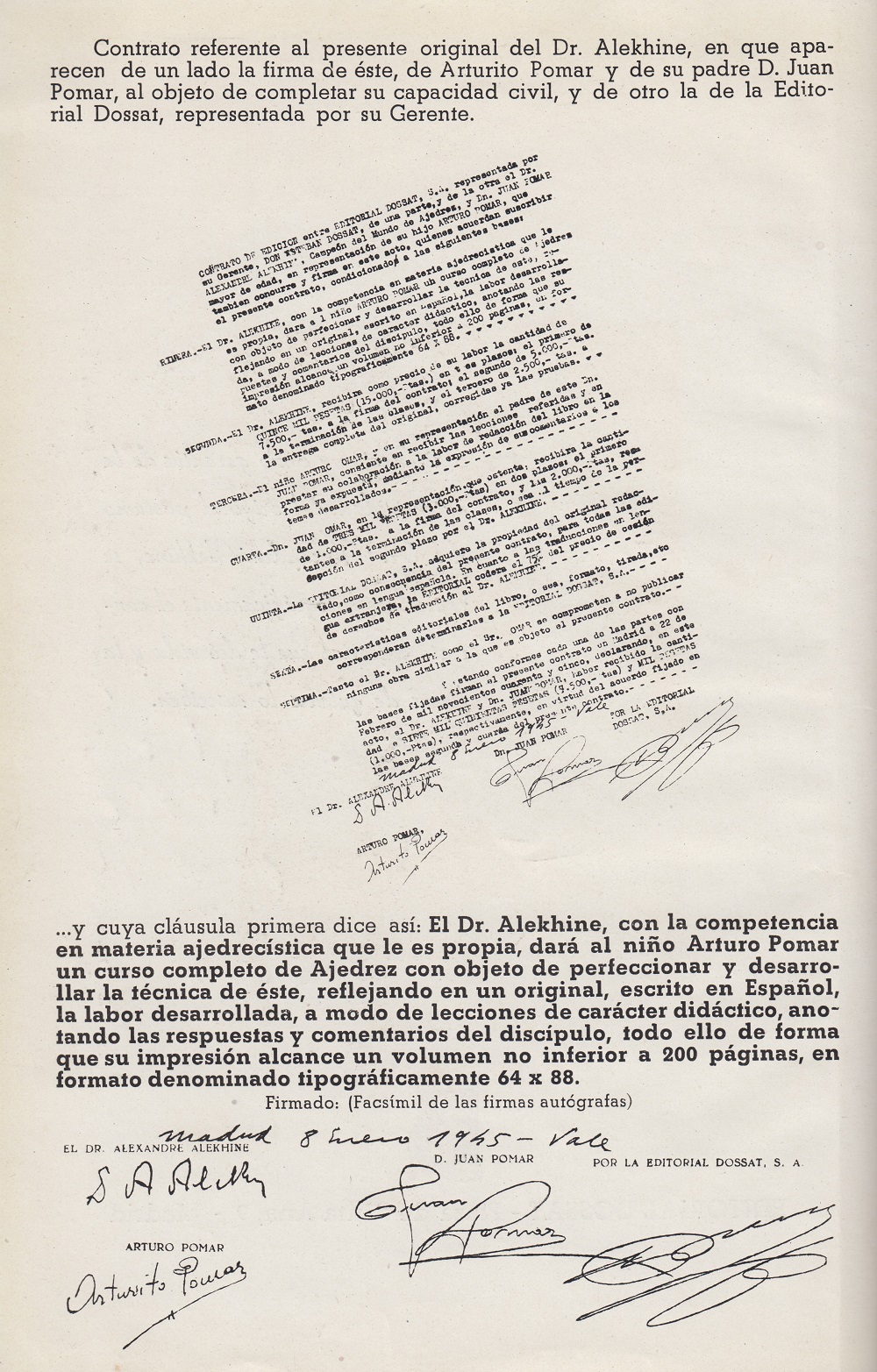
On page 8 of La vida de Arturito Pomar by Juan M. Fuentes and Julio Ganzo (Madrid, 1946):

A photograph opposite page 145:

From opposite page 225:
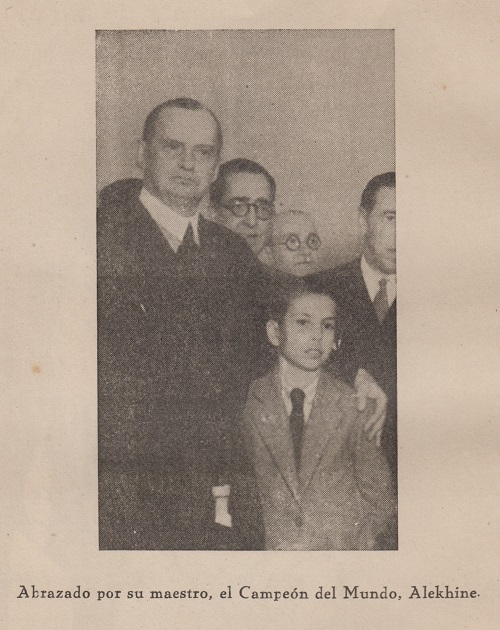
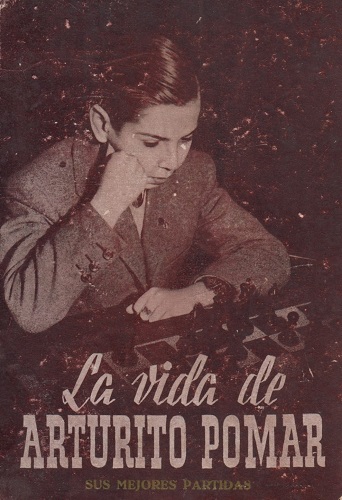
A photograph on page 135 of CHESS, March 1946:
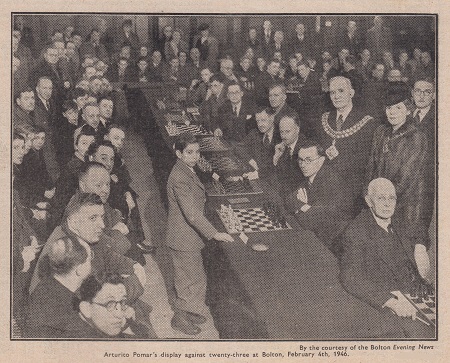
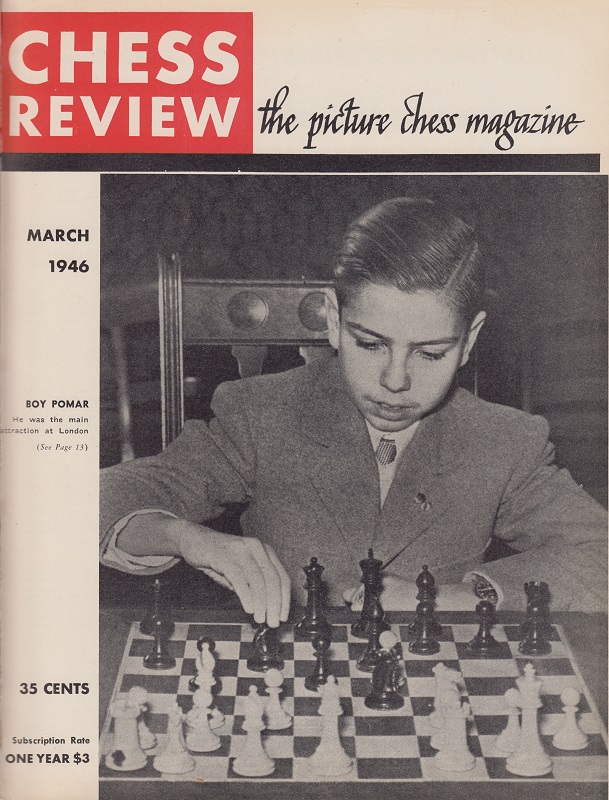
A shot on page 12 of Chess Review, March 1946:
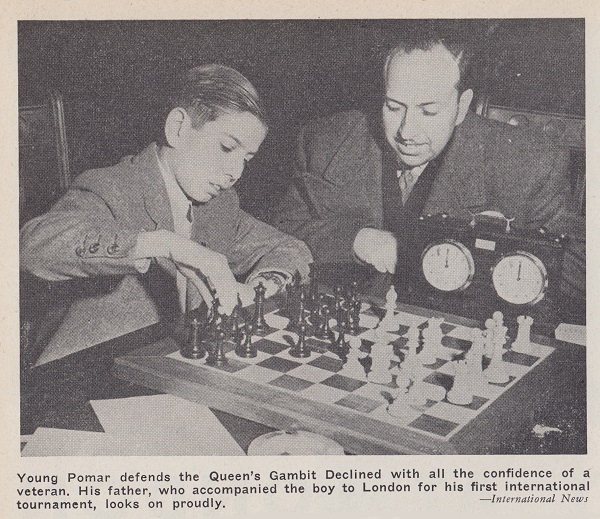
From page 36 of Chess Review, February 1956:
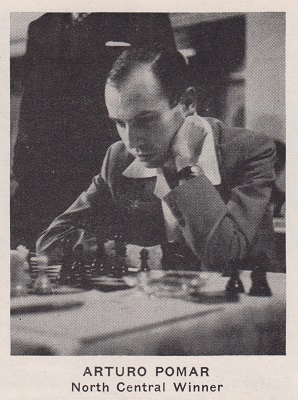
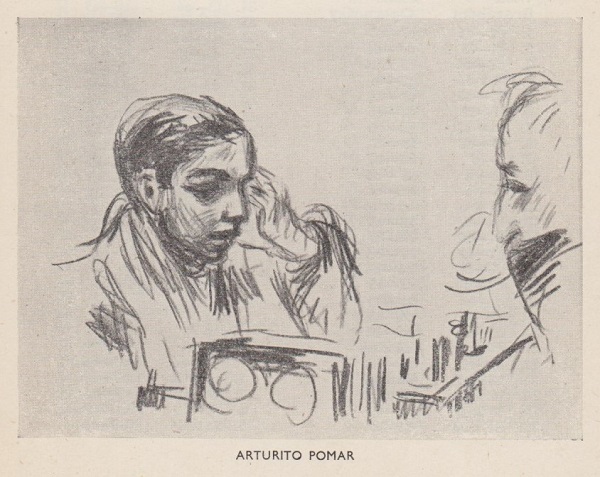
London 1946 Book of the “Sunday Chronicle” Chess Tournament (Sutton Coldfield, 1946), page 39
At the age of 14 Arturo Pomar won the 1946 Spanish championship in Santander, as reported on pages 209 and 213 of Ajedrez Español, July 1946:

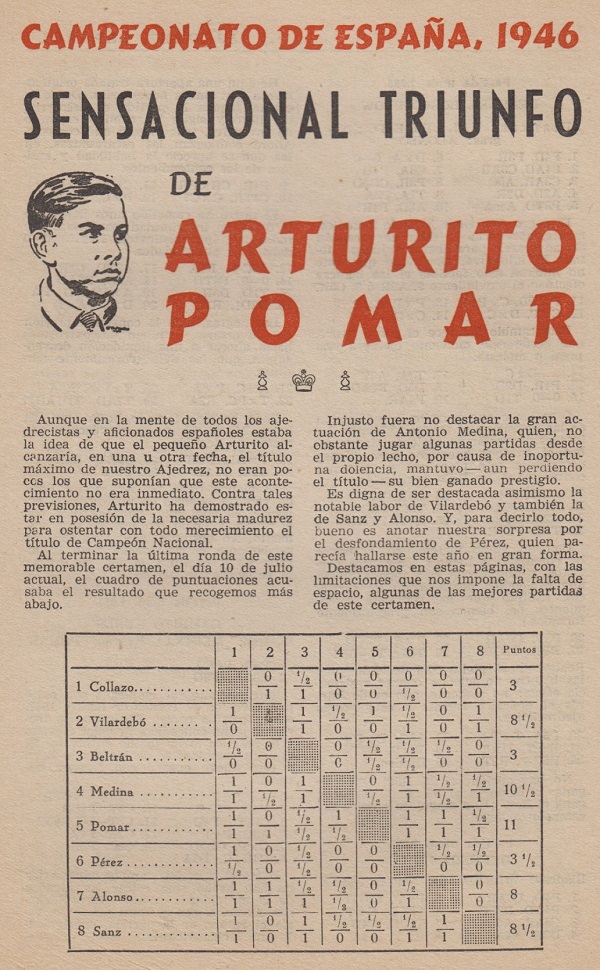
On pages 378-379 of the December 1946 issue Pomar annotated two games from the championship:
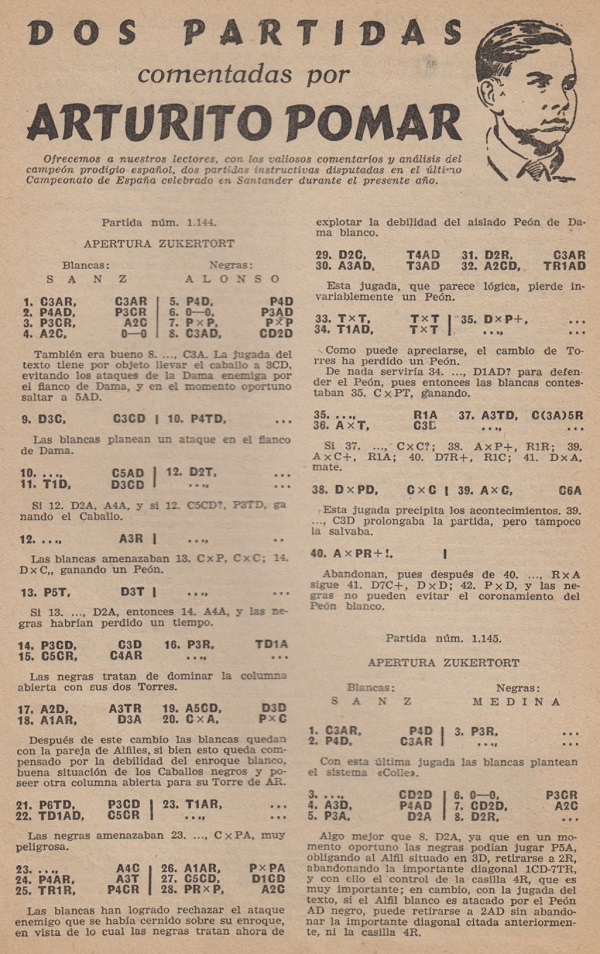
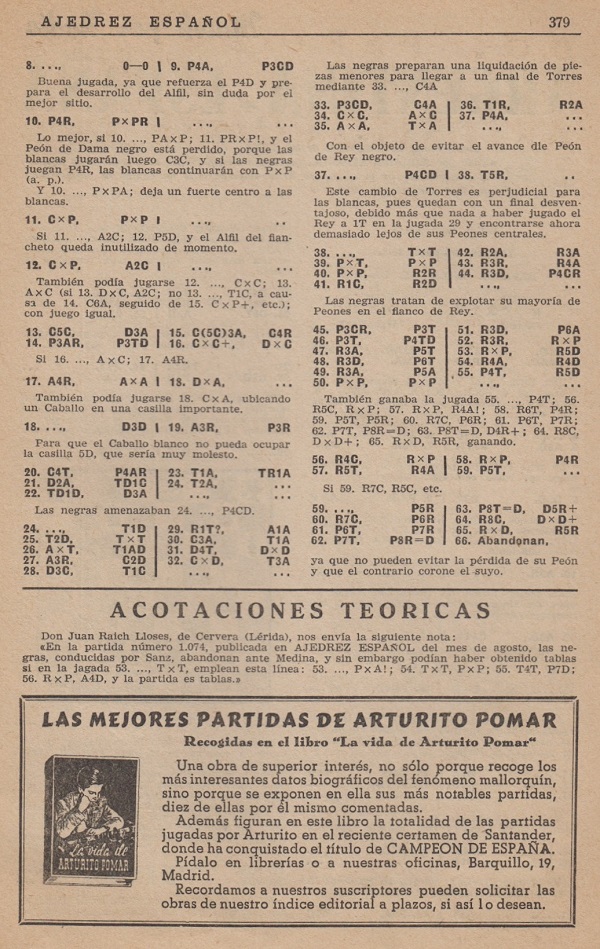
Sanz v Alonso: 1 Nf3 Nf6 2 c4 g6 3 g3 Bg7 4 Bg2 O-O 5 d4 d5 6 O-O c6 7 cxd5 cxd5 8 Nc3 Nbd7 9 Qb3 Nb6 10 a4 Nc4 11 Rd1 Qb6 12 Qa2 Be6 13 a5 Qa6 14 b3 Nd6 15 Ng5 Nf5 16 e3 Rac8 17 Bd2 Bh6 18 Bf1 Qc6 19 Bb5 Qd6 20 Nxe6 fxe6 21 a6 b6 22 Rac1 Ng4 23 Rf1 Bg5 24 f4 Bh6 25 Rfe1 g5 26 Bf1 gxf4 27 Nb5 Qb8 28 exf4 Bg7 29 Qb2 Rc5 30 Bc3 Rc6 31 Qe2 Nf6 32 Bb2 Rfc8 33 Rxc6 Rxc6 34 Rc1 Rxc1 35 Qxe6+ Kf8 36 Bxc1 Nd6 37 Ba3 Nfe4 38 Qxd5 Nxb5 39 Bxb5 Nc3 40 Bxe7+ Resigns.
Sanz v Medina: 1 Nf3 d5 2 d4 Nf6 3 e3 Nbd7 4 Bd3 c5 5 c3 Qc7 6 O-O g6 7 Nbd2 Bg7 8 Qe2 O-O 9 c4 b6 10 e4 dxe4 11 Nxe4 cxd4 12 Nxd4 Bb7 13 Nb5 Qc6 14 f3 a6 15 Nbc3 Ne5 16 Nxf6+ Qxf6 17 Be4 Bxe4 18 Qxe4 Qd6 19 Be3 e6 20 Na4 f5 21 Qc2 Rab8 22 Rad1 Qc6 23 Rc1 Rfc8 24 Rf2 Rd8 25 Rd2 Rxd2 26 Bxd2 Rc8 27 Be3 Nd7 28 Qb3 Rb8 29 Kh1 Bf8 30 Nc3 Rc8 31 Qa4 Qxa4 32 Nxa4 Rc6 33 b3 Nc5 34 Nxc5 Bxc5 35 Bxc5 Rxc5 36 Re1 Kf7 37 f4 b5 38 Re5 Rxe5 39 fxe5 bxc4 40 bxc4 Ke7 41 Kg1 Kd7 42 Kf2 Kc6 43 Ke3 Kc5 44 Kd3 g5 45 g3 h6 46 h3 a5 47 Kc3 a4 48 Kd3 a3 49 Kc3 f4 50 gxf4 gxf4 51 Kd3 f3 52 Ke3 Kxc4 53 Kxf3 Kd4 54 Kf4 Kd5 55 h4 Kd4 56 Kg4 Kxe5 57 Kh5 Kf5 58 Kxh6 e5 59 h5 e4 60 Kg7 e3 61 h6 e2 62 h7 e1(Q) 63 h8(Q) Qe5+ 64 Kg8 Qxh8+ 65 Kxh8 Ke4 66 White resigns.
(9940)
From the Palma de Mallorca, 1969 tournament book:

Arturo Pomar
A Spanish website has a large number of chess photographs. One recommended search, ‘ajedrez 1943’, gives these 12 shots:
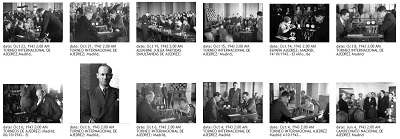
(9978)
Another photograph of Pomar with Alekhine is on page 304 of Alexander Alekhine: Zhizn i igra by I. and V. Linder (Moscow, 2007), credited to the 3/2003 issue of Rochade Europa.
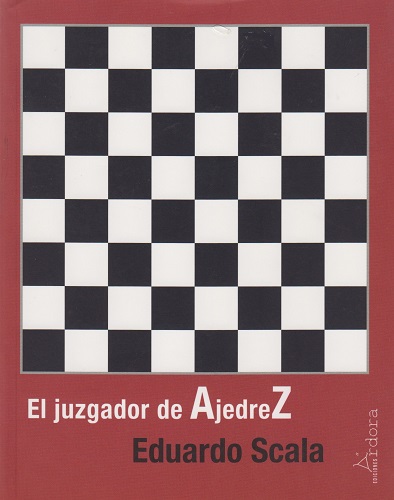
Pages 88-92 of El juzgador de AjedreZ by Eduardo Scala (Madrid, 2014) present a previously unpublished interview with Arturo Pomar (Barcelona, 13 November 1991). In an exchange on page 89 Pomar spoke warmly of Alekhine:
‘– ¿Qué pensaba Alekhine del niňo prodigio, cuando intentó instruirle en esta materia?
– El Dr. Alekhine siempre me trató con mucho afecto. Era un poco impaciente, eso sí; alguna vez se irritaba cuando no coincidíamos en los criterios. Era una buena persona; se tomó con mucha resignación que yo le entablara en el Torneo de Gijón cuando tenía 12 aňos.’
(10040)
Arturo Pomar is the subject of the latest book that we have acquired, El peón by Paco Cerdà (Logroño, 2020):
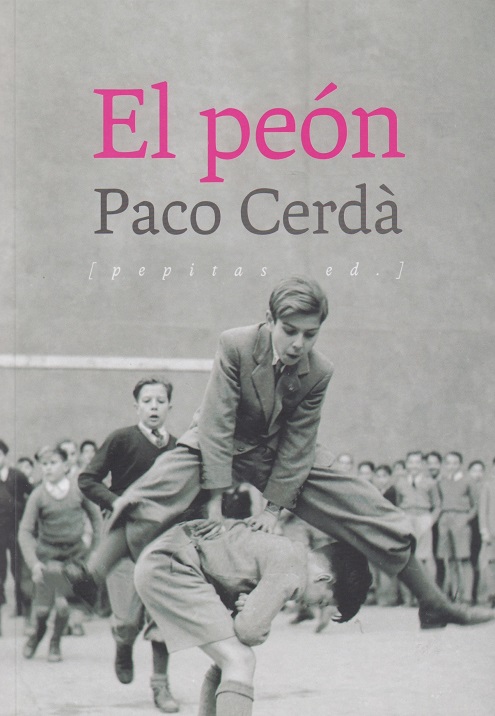
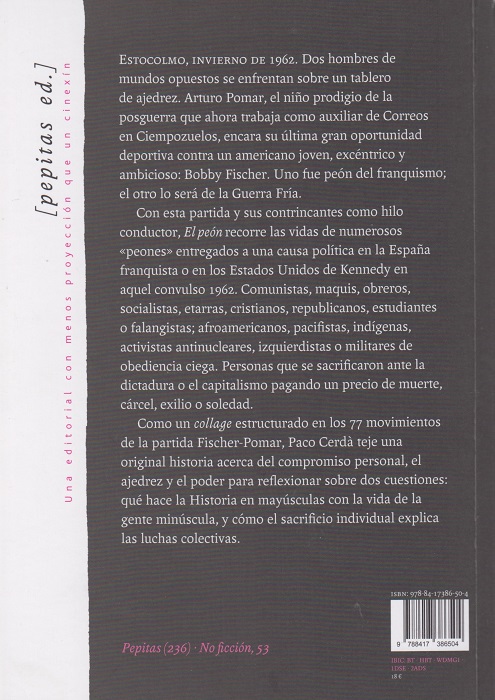
Addition on 15 June 2025:
An English translation, by Kevin Gerry Dunn, has appeared, under the title The Pawn. See also the Deep Vellum webpage.
To the Chess Notes main page.
To the Archives for other feature articles.
Copyright: Edward Winter. All rights reserved.